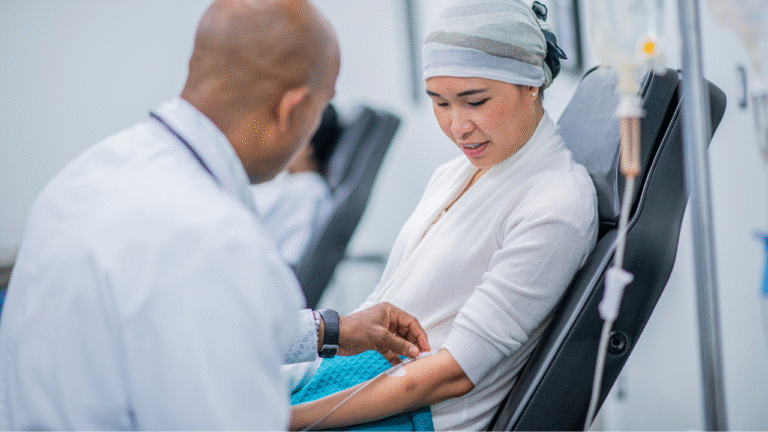Transcranial Magnetic Stimulation (TMS) therapy is increasingly recognised as a non-invasive treatment option for mental health conditions. It is already registered on the Medicare Benefits Scheme for a rebate when treating major depressive disorder (MDD).
As an investigational treatment for many more conditions, particularly for individuals who have not responded to traditional treatments such as medication or psychotherapy, TMS is becoming more widely considered in Australia. Here’s an overview of why TMS is gaining attention and its role in mental health care.

Medication-Free Treatment for Depression
TMS therapy offers a medication-free approach to managing depression, appealing to those who experience side effects from antidepressants, such as weight gain, fatigue, or sexual dysfunction, or who find medications ineffective. Unlike systemic treatments, TMS targets specific brain areas involved in mood regulation, avoiding widespread effects on the body.
Supported by Evidence and Regulatory Approval
TMS devices are registered with the Therapeutic Goods Administration (TGA) in Australia for treating major depressive disorder (MDD) and obsessive-compulsive disorder (OCD). Research also indicates potential benefits for conditions like:
- Postnatal Depression
- Late-Life Depression
- Obsessive-Compulsive Disorder
- Anxiety
- Post-Traumatic Stress Disorder (PTSD)
- Smoking Addiction
- Bipolar Disorder
- Post Stroke Rehab
- Schizophrenia
As ongoing studies continue to explore its applications, there is growing awareness and confidence amongst healthcare professionals and patients.
Minimal Side Effects
TMS therapy is associated with minimal side effects compared to some other mental health treatments. Common side effects include mild scalp discomfort or a temporary headache during or after sessions. Unlike ECT, TMS does not require sedation, so patients can return to daily activities immediately. This makes it suitable for those with busy schedules, such as professionals, parents, carers and students.
Increased Availability and Funding Support
The availability of TMS therapy is expanding as more Australian clinics offer the treatment. Some private health insurance funds and Medicare may provide coverage for TMS in cases of treatment-resistant depression, subject to eligibility criteria. This increased accessibility makes TMS a more viable option for many Australians.
Tailored and Precise Treatment
The latest advancements in TMS technology allow treatments to be personalised – that is customised to an individual’s needs and unique anatomical characteristics. Through techniques like brain mapping, clinicians can target specific brain regions, potentially enhancing treatment outcomes. This personalised approach can then be used to address each patient’s unique condition(s), by targeting the involved regions of the brain.


Conclusion
TMS therapy is gaining attention in Australia due to its non-invasive nature, increasing evidence base, patient and practitioner support and different side effects than medication or more invasive forms of treatments. For individuals exploring alternatives to traditional mental health treatments, TMS may be an option worth discussing with a qualified healthcare professional.
To learn more about TMS therapy or determine if it’s suitable for you, consult your doctor or a mental health specialist. They can provide guidance based on your individual circumstances.
FAQ about CRPS
Complex Regional Pain Syndrome (CRPS) most commonly develops following an injury or surgery to a limb, even if that initial trauma seemed minor. The exact mechanisms aren’t fully understood, but several factors contribute:
Nerve dysfunction and inflammation: After trauma, peripheral and central nervous system changes (including altered neurotransmitter release, signaling pathways, and neuroinflammation) can perpetuate pain signals beyond normal healing.
Autonomic changes: Abnormal sympathetic activity may lead to vasomotor and sudomotor disturbances (skin colour/temperature changes, swelling), characteristic of CRPS.
Central sensitisation: Repeated pain input can “rewire” brain networks involved in pain processing, leading to persistent pain, allodynia (pain from light touch), and hyperalgesia (exaggerated response to painful stimuli).
Genetic and psychosocial factors: Whilst we don’t understand it complete, individual genetic predispositions and stress, anxiety, or depression may modulate susceptibility and symptom severity.
Diagnosis by a clinician and guided by the “Budapest Criteria.” Essentially, a clinician will look for:
Persistent, disproportionate pain in the affected limb (burning, throbbing, stabbing) lasting longer than expected for the inciting event.
Signs in at least three of four categories:
Sensory: Allodynia or hyperalgesia (e.g., light touch or temperature changes are painful).
Vasomotor: Skin colour changes, temperature asymmetry.
Sudomotor/Edema: Swelling, abnormal sweating, changes in nail or hair growth.
Motor/Trophic: Decreased range of motion, weakness, tremor, dystonia.
No other diagnosis better explains the symptoms.
Confirmatory tests (e.g., bone scans, thermography, quantitative sensory testing) are sometimes used, but there is no single “gold standard” test. A detailed history, physical examination, and appropriate imaging or nerve conduction studies help rule out mimicking conditions.
Management aims to reduce pain, restore function, and prevent progression. A multidisciplinary, stepped‐care approach is recommended:
Pharmacological therapies (standard of care):
Analgesics and anti-inflammatories: NSAIDs, acetaminophen (paracetamol) for mild relief.
Neuropathic pain agents: Gabapentin, pregabalin, tricyclic antidepressants (e.g., amitriptyline), serotonin–noradrenaline reuptake inhibitors (e.g., duloxetine).
Topical treatments: Lidocaine patches or capsaicin cream for localized pain.
Sympathetic blocks: Stellate ganglion or lumbar sympathetic blocks may transiently reduce vasomotor symptoms and pain.
Physical and occupational therapy:
Graded motor imagery and desensitisation: Retrains the brain’s perception of the affected limb.
Range‐of‐motion and strengthening exercises: Prevent joint stiffness and muscle atrophy.
Occupational therapy: Adaptive strategies to maintain independence.
Interventional neuromodulation (investigational at our clinic):
Repetitive Transcranial Magnetic Stimulation (rTMS): A non-invasive therapy that uses MRI‐guided, neuronavigated magnetic pulses to modulate pain‐processing regions in the brain (primary motor cortex, DLPFC, etc.).
Evidence in CRPS:
Pilot studies (e.g., Picarelli et al., 2010; Gaertner et al., 2018; Chang et al., 2020) show that 5–10 sessions of high‐frequency rTMS (≥10 Hz) alone or primed with theta‐burst stimulation can yield a cumulative reduction in pain (often ≥30% on VAS) that persists for ≥1 week post‐treatment.
rTMS appears to stimulate neurogenesis, enhance neuroplasticity, and normalize dysfunctional pain circuits (e.g., nigrostriatal‐thalamo‐cortical pathways).
At Brain Aid Clinics, rTMS for CRPS remains investigational—no outcomes are guaranteed, and only offered after comprehensive screening, informed consent, and under strict clinical protocols.
Complementary therapies (adjunctive support):
Acupuncture: Some patients report modest, short‐term relief from acupuncture, likely due to endogenous opioid release and modulation of peripheral sensitisation. Small trials in neuropathic pain suggest benefit, but evidence in CRPS is still emerging.
Hypnotherapy: May help reduce catastrophising and improve coping, though data in CRPS is limited. Patients with high anxiety or catastrophising scores may derive extra benefit.
Mindfulness‐based stress reduction (MBSR): Can decrease central sensitisation and improve quality of life.
Nutrition and lifestyle support: Addressing inflammation (e.g., omega-3 fatty acids, antioxidants) and improving sleep/stress resilience through our Thought Movement Food™ program can be valuable adjuncts.
Psychological and psychiatric support:
Cognitive Behavioural Therapy (CBT), Acceptance and Commitment Therapy (ACT): Improve pain coping strategies, reduce fear‐avoidance, and address depression/anxiety.
Surgical and advanced pain techniques (for refractory cases):
Spinal cord stimulation (SCS): Implantable devices can in some cases reduce pain by >50%.
Intrathecal drug delivery: Morphine or baclofen pumps for severe, unresponsive CRPS.
CRPS can be challenging to “cure,” especially once it progresses beyond early stages. However:
Early intervention (within months of onset)—multidisciplinary therapies often resolve symptoms or minimise long‐term disability in many patients.
Chronic cases may not fully remit, but pain intensity and functional impairment can often be substantially reduced with a combination of therapies (e.g., rTMS, PT, medications, psychological support).
Individual outcomes vary: Some achieve complete remission, others stabilise with manageable symptoms, and a small subset may continue to experience persistent, severe pain despite best efforts.
Yes. In order to ensure the safest and most appropriate care, we require:
Referral from a General Practitioner (GP) or Specialist (e.g., neurologist, pain physician, rheumatologist) who has documented your CRPS diagnosis or strong suspicion of CRPS based on the Budapest Criteria.
Recent clinical notes and investigations (e.g., imaging, nerve conduction studies) help our team tailor an effective treatment plan.
Absolutely. We collaborate closely with:
GPs and specialists (neurologists, pain physicians, orthopaedic surgeons, rheumatologists) for co‐management of medications, diagnostic workup, and interventional procedures (e.g., nerve blocks, SCS).
Physiotherapists and Occupational Therapists to design graded motor imagery, desensitisation, and functional rehabilitation programs.
Psychologists and Psychiatrists for CBT, ACT, and medication management of mood/anxiety disorders.
Dietitians and Exercise Physiologists as part of our Thought Movement Food™ lifestyle program for anti‐inflammatory nutrition, graded exercise, and sleep optimisation.
Obtain a referral letter from your GP or specialist indicating a suspicion or diagnosis of CRPS.
Email info@brainaidclinics.com or call 0466 352 811 to speak with our medical liaison or relationship manager.
We will schedule an initial telehealth consultation (or in‐person if you are local to Gold Coast) to review your history, confirm diagnostic criteria, and plan any necessary imaging or diagnostic tests.
Once the referral and preliminary screening are complete, we arrange an in‐person assessment with one of our rTMS psychiatrists or pain specialists.
Wait times vary depending on referral volume. Typically, we aim to schedule your initial telehealth assessment within 2–4 weeks of receiving a complete referral.
Urgent cases (e.g., acute CRPS flare, rapidly deteriorating function) can often be expedited—please have your GP or Specialist note the urgency in the referral.
Yes. We provide:
Telehealth initial assessments for patients anywhere in Australia. This covers detailed history‐taking, medication review, and discussion of initial management steps.
Ongoing telehealth follow‐ups for treatment monitoring, medication titration, and lifestyle coaching (e.g., Thought Movement Food™ guidance).
Note: rTMS treatment itself must be delivered in‐person at one of our clinics.
Medicare: Most CRPS consultations (telehealth or in‐person) with our psychiatrists and pain specialists are billed under standard Medicare items for allied mental health or pain medicine follow‐up. However, rTMS for CRPS remains “investigational,” so there is no specific Medicare Benefit Schedule (MBS) item number to cover the rTMS device sessions for CRPS. Patients must self‐fund investigational rTMS.
Private Health Insurance:
Consultations, allied health visits (physio, OT, psychology), and any MRI scans can usually be claimed under your extras cover if you have an appropriate level of private health insurance.
Investigational rTMS sessions for CRPS are generally not covered—some insurers may consider exceptions if a clinical trial or compassionate access program is in place. We recommend checking directly with your provider.
Public Pain Clinics and Trials: In some states, you may be eligible for subsidised services at a public multidisciplinary pain clinic. If you qualify for a state‐funded CRPS trial (e.g., an rTMS research study), treatment costs may be partially or fully covered—ask your GP or specialist about current clinical trials (e.g., at university hospitals).
